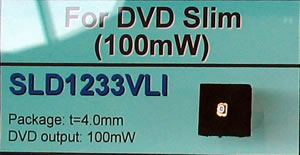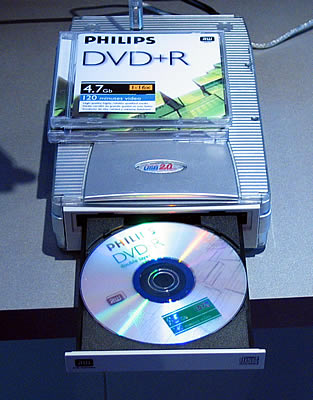
Philips demonstrated double layer DVD recording as well as 16x DVD recording for DVD+R. Double layer DVD+R technology has been jointly developed by Philips and Mitsubishi Kagaku Media (MKM), doubling the data capacity of recordable DVD to 8.5GB.

The companies had to overcome significant technological challenges for recording on to two layers. Development of the appropriate double layer organic media (MKM), the logical formatting as well as the hardware implementation of the technology were issues to be faced.
One challenge to overcome was to minimize the interference between data recorded in the first layer while recording on the second layer. In addition, the first layer requires the use of a transparent thin metal layer that will allow the light beam to penetrate onto the second layer without affecting the first layer. Towards this direction, MKM developed new materials used for the spacer layer, the transparent metal reflector.

According to the standard, reflection back off any layer must be above 18% to ensure proper operation, especially in the case of defective media where the surface may have fingerprints for example and the signal must be strong enough to overcome losses caused by any defects. This also applies to dual layer writing, where part of the signal destined for the second layer is absorbed by the top layer. Here, Philips has managed to achieve 50% reflection, well above the 18% minimum.
Another issue with dual layer media is the addressing strategy which must be implemented. When writing on a dual layer disc, logically the entire 8.5Gbytes appears as one contiguous stream. Physically this is not the case however, and this poses a problem when part of the disc is left unrecorded. Any part of the disc that is not been recorded on, must be "de-iced", ie filled with dummy data, which is similar to formatting a hard disk for example.
The reason for this has to do with compatitbilty. For example, take a disc on which the entire first layer and part of the second layer have been written on. When this disc is then read, and a seek on the first layer to some point further ahead is requested which will move forward to a point on the second layer, there are two possible methods the reading drive can adopt (the standard itself does not define what the behaviour in such a situation should be). The first is to seek forward until it reaches the end of the first layer, switch to the second layer (OTP), continue seeking forwards until it reaches the desired point.
The second method is to simply jump from the first layer, at the point from which the request is made, directly onto the same position on the second layer and back up until it reaches the desired position. If the point at which the switch from the first layer to the second layer is made, the second layer has not been "de-iced", the reading drive will not be able to determine its position since there is no address information available on the unwritten portion of the disc. Hence, de-icing the unwritten parts of the disc simply allows a drive using this approach to navigate the entire drive without "getting lost".
Philips uses a single laser diode for recording on the two layers. Recording is done at 2.4x for both layers, since higher speeds would require more power. Currently, the laser power for recording at 2.4x has been kept lower than 30mW for both layers. So the drive only adjusts the laser focusing point in order to record on the first or the second layer. In addition, the data-to-clock jitter is less than 9.0% for both layers.
The first Philips drive to support double layer is the DVDRW885. The drive support 8x writing for DVD+R (4.7GB) Z-CLV, 2.4x CLV for DVD+R9 (8.5GB), 4x for DVD-R, 2x for DVD-RW, 4x for DVD+RW, 24x CD-R and 10x CD-RW.In the reading part, the supported speeds are 12x on DVD-ROM, 7x on DVD+R DL, 7x on DVD+R, 7x on DVD+RW,7x on DVD-R, 7x on DVD-RW, 40x on CD-R, 32x on CD-RW. Of course, the drive uses a different laser diode for CD recording/reading. Availability on the market is expected by May.
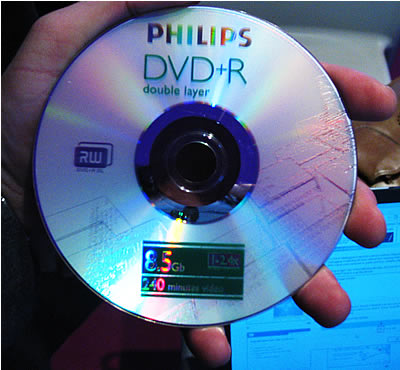
We witnessed a demonstration of a dvd video compilation written onto double layer media which took a little over 39 minutes (7.034 GBytes). The recorded disc was then played on a standard dvd player for confirmation, where both layers were read without problems.
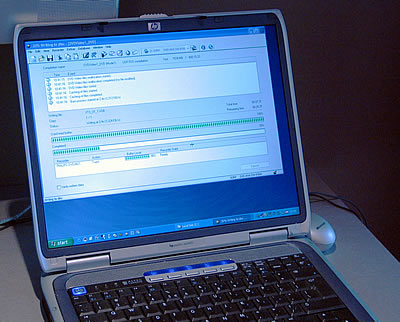
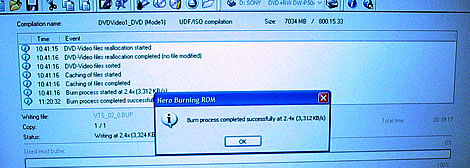
Below you can see the NeroCDSpeed reading graph of th erecorded DVD+R9 disc:

Transfer Rate
Start 3.15x
End 6.44x
Average 5.01x
Type CAV
The first Philips 16x DVD+RW burner is the DVDR1640, to be available by June. The drive records at 16x CAV on DVD+R media, and also is capable of DVD+R9 writing. The basic features include the Dynamic Calibration to ensure writing quality at high DVD speeds, the Seamless Link technology and and the Optimum recording speed feature that selects the appropriate writing speed for any recordable disc. The detailed specifications of the new drive are available below:
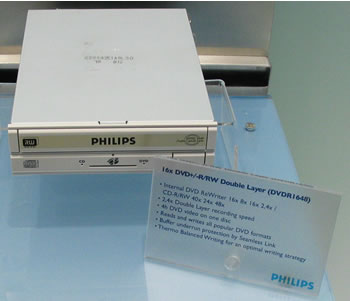
Philips Nexperia reference kit

Laser diodes


